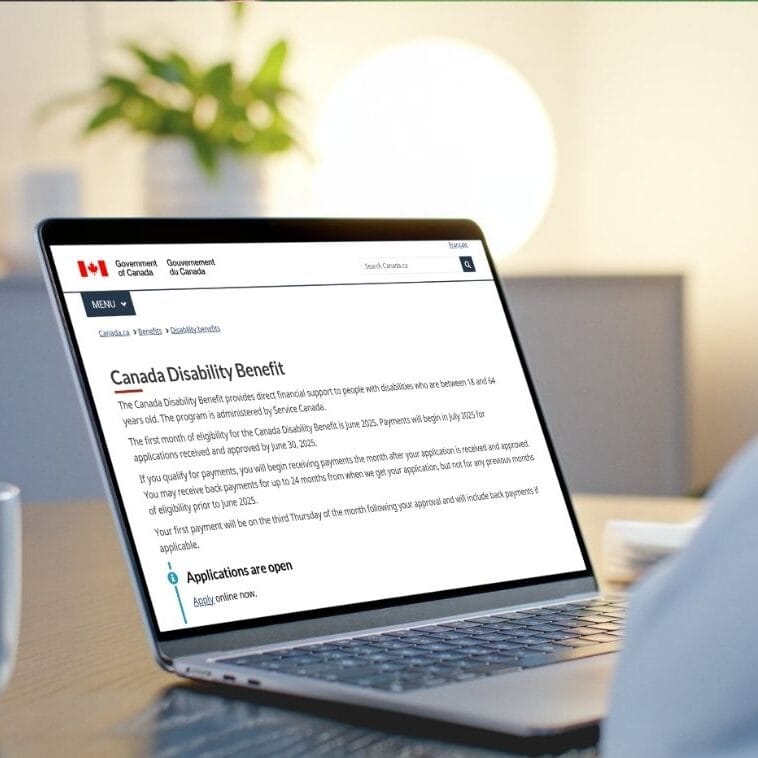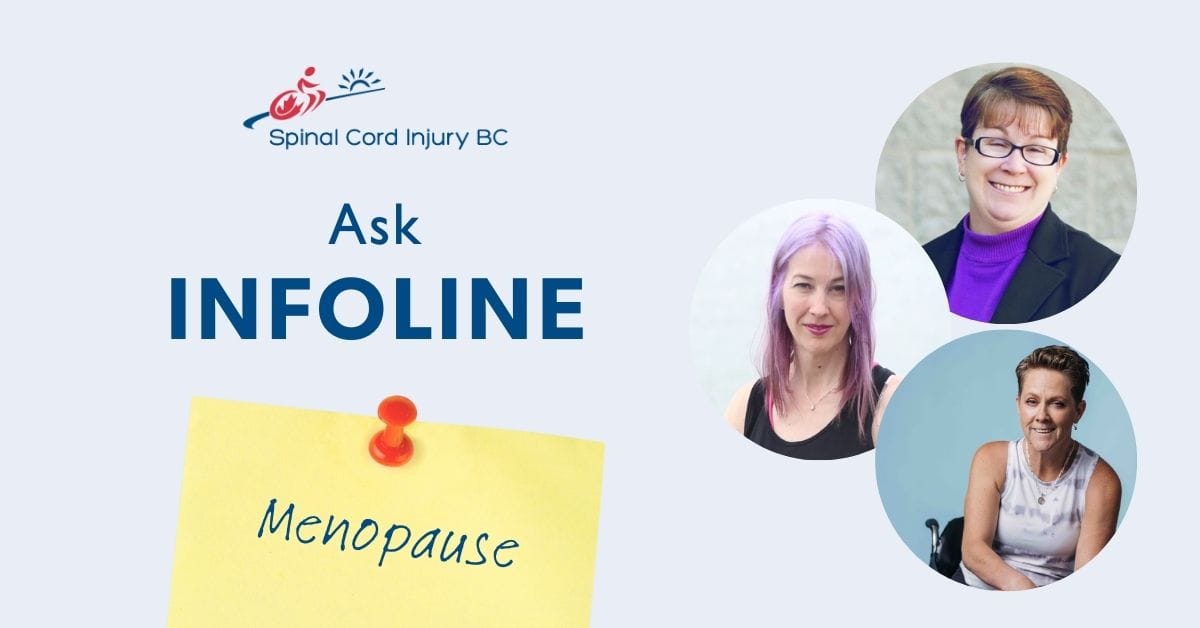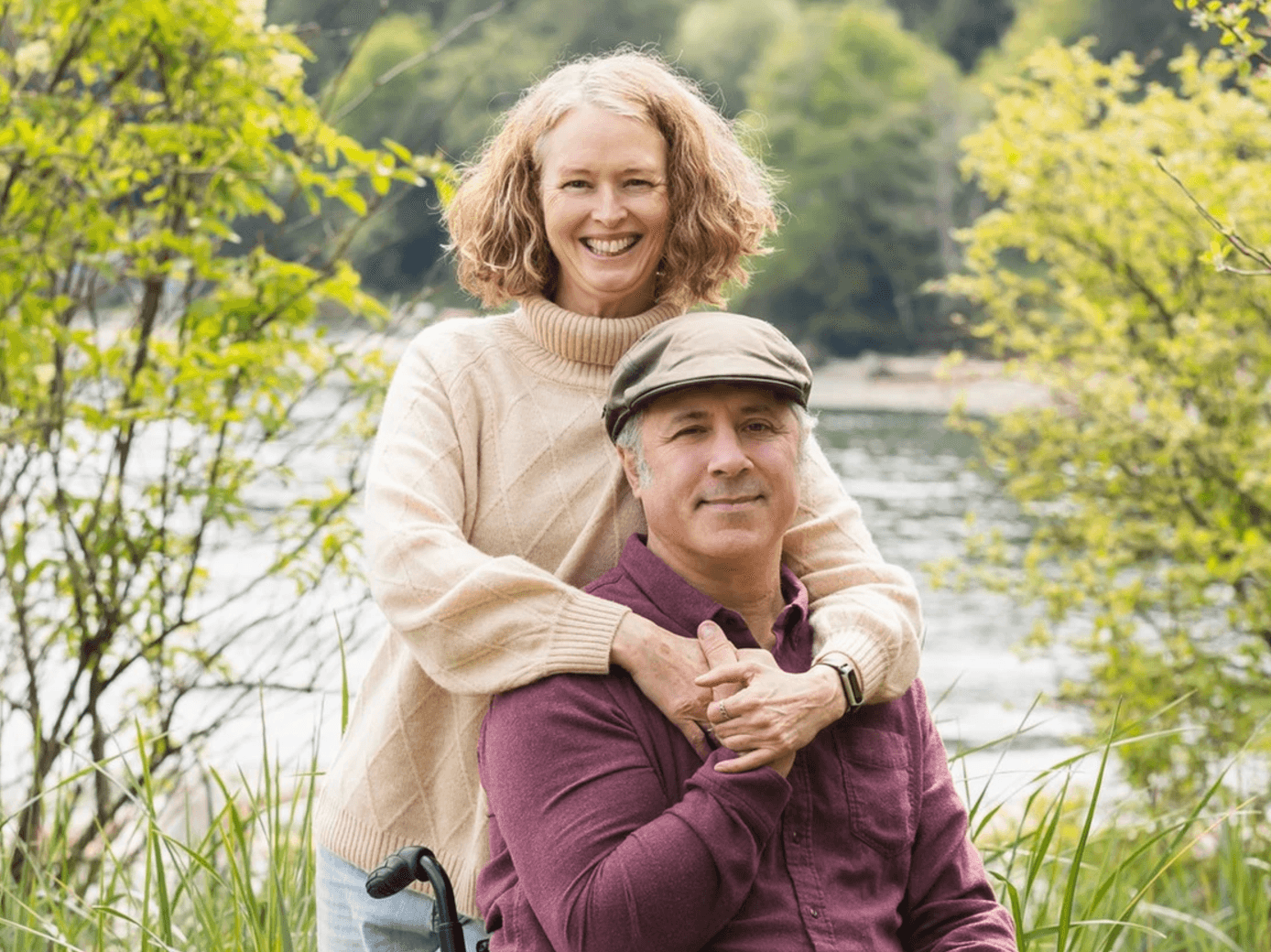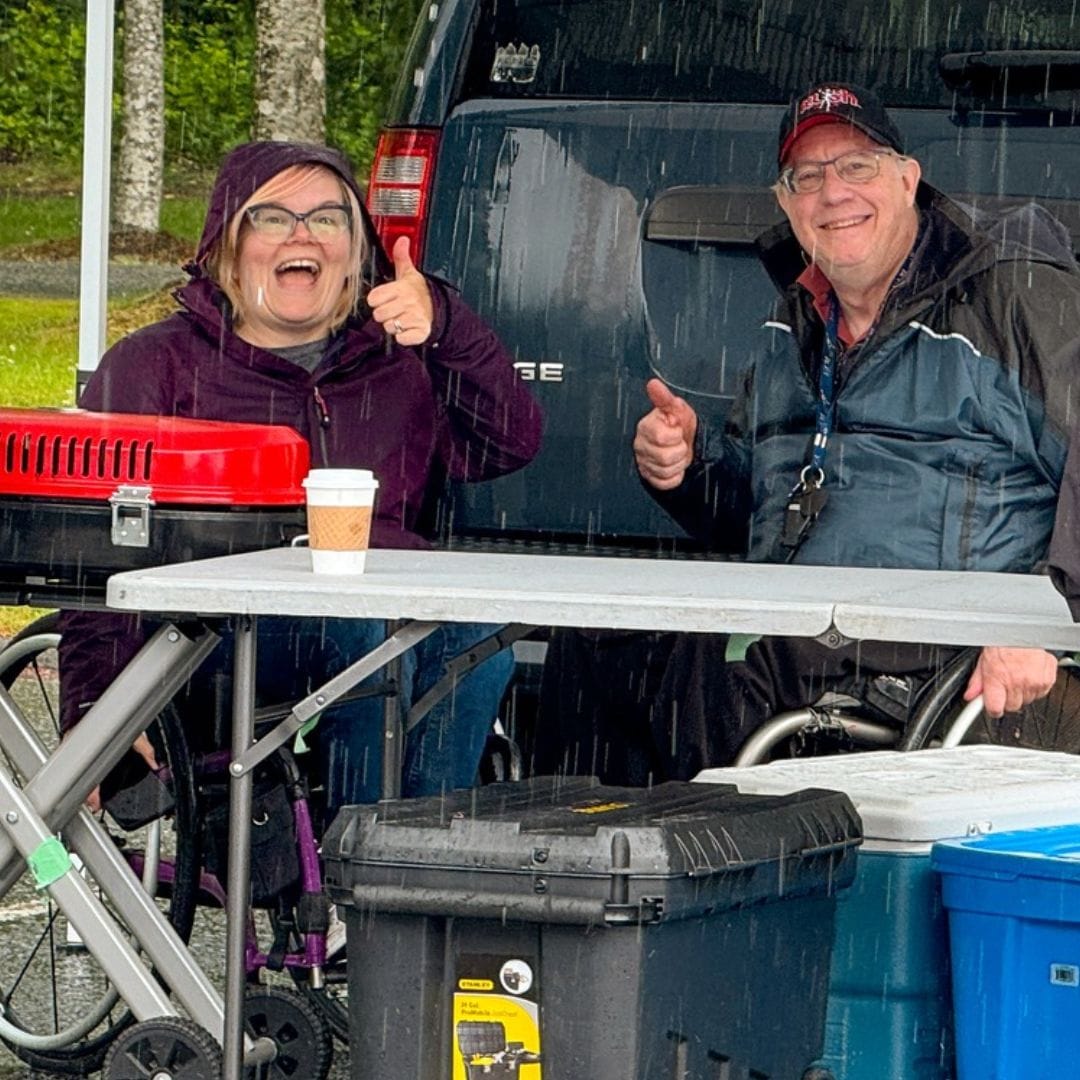
ROB MABEY | Kelowna, BC
C5/C6 complete
23 years post-injury
Where do you go when the colder weather hits BC?
A little town close to the southern tip of the Baja Peninsula [in Mexico] called Los Barriles.
How long have you been snowbirding?
Since 2017… My kids got to university age and decided to attend the University of Calgary. I realized then that I didn’t have to stay in Canada for the winter months that they were at school.
Why did you start travelling during the winter? What was the main reason?
The main reason for wanting warmer weather was the hassle of pushing through snow and ice in a wheelchair. As a C5/C6 quadriplegic with no hand function, once you lose traction on your push rings when they get wet and cold you’re pretty much dead in the water. Not to mention, having to bundle up with clothing just to keep warm… I figured pushing through sand in a cut off shirt and shorts is far better than pushing through snow and ice looking like the Michelin man!
How do you travel to your snowbird destination?
My preferred method of travel is driving. It gives me the freedom to enjoy the journey and explore on my way to the destination. My first [travel] vehicle was a Ford Flex with an adapted travel trailer. It was a 16-foot trailer that I had modified to go camping with my kids. I had to do some further modifications like putting a lift on the side to make it more independent.
The second iteration was a Sprinter van with custom building on the inside into a full motorhome. It has a lift in the side door, a full queen bed, shower, toilet, heater, hot water, and refrigerator. [It allows] my wheelchair to roll back-and-forth, turn around, and transfer from the bed to the toilet and shower. Because prebuilt motorhomes and Sprinter vans are very expensive (and I would have to carve them up to accommodate the wheelchair anyway) I chose to custom build the van in my driveway. I pull a utility trailer behind the van to carry my front drive attachment, hand cycle, and various medical supplies. Typically, the van is fully equipped with all of my clothes and toiletries, food [and solar power], so it is self-sustaining.
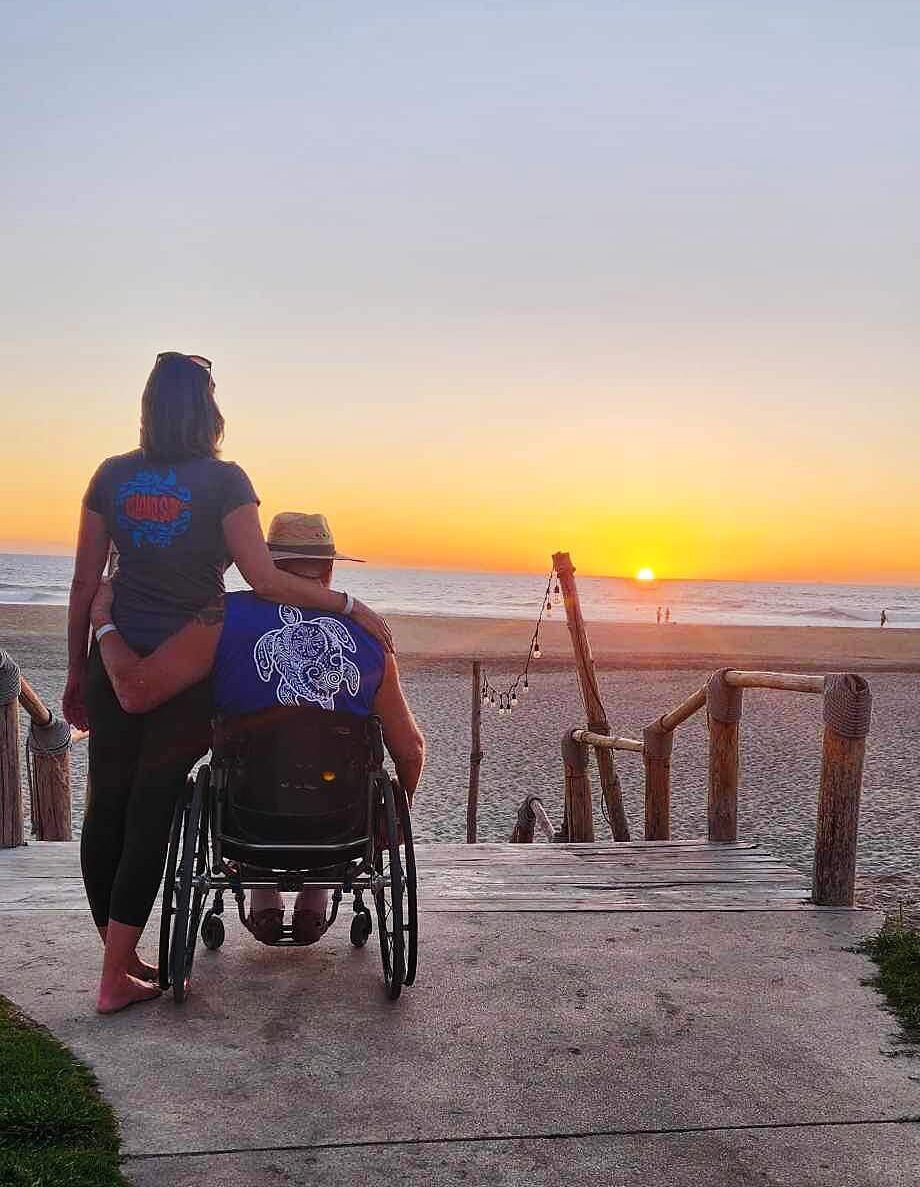
How do you prepare for health-related issues, equipment needs, or medication requirements while you’re away?
Because I drive, all my SCI related equipment and supplies are typically brought with me in the trailer. However, there is opportunity [in] the United States and Mexico to acquire most of the supplies [if you need to], it’s just harder.
Health insurance is very important to travel with—especially through the States. A spinal cord injury is not considered a pre-existing condition, so you’re not penalized for being in a wheelchair. [Receiving] healthcare in Mexico is much more affordable, especially for small ailments. I have direct experience with the Mexican medical process as I spent 16 days in a Mexican hospital last spring [and] was air-ambulanced out of Mexico back to Canada to spend another two and a half months in the hospital in Canada.
Have you encountered any unexpected challenges while snowbirding abroad? What has been your worst experience?
By far the most unexpected challenge was the medical event that led to my air ambulance evacuation back to Canada. [The second most unexpected thing happened] in Venice Beach—apparently, it’s a thing there to grab people in wheelchairs and push them at high speeds along the boardwalk! When this happened to me, I was yelling at [the people] to stop and when they did—Newton’s Law of ‘things in motion tend to stay in motion, unless acted upon by an equal or opposite force’ came into effect. I believe the teenagers [who pushed me] were [intoxicated], but nevertheless, when they stopped the chair, I flew forward about 10 or 15 feet [and landed] ragdoll on the pavement. They took off and some bystanders came to help me back into the chair. Luckily, upon doing a quick visual check that night, nothing was broken or damaged, just a few bruises.
In your opinion, what’s the best part about being a snowbird?
The best part of spending time out of the winter is simply the warm weather. You tend to be more active and the extra vitamin D doesn’t hurt! One of my mottos… is “move it or lose it.” As a C5/C6 quadriplegic it’s even more important as you have so little muscle to move your entire body. If you lose that, you become very dependent. [The warm weather] is simply a far more healthy environment in my opinion, both physically and mentally.
What is the biggest lesson you’ve learned since you started moving away for the winter?
My biggest takeaway from travelling is a faith in humanity. Ninety-nine percent of people out there are simply living their lives and aren’t concerned about you or your stuff… Consistent with our current political environment there is a lot of misinformation out there. I have broken down various times in Mexico and people are more than willing to help and go out of their way to make sure you’re OK. I’ve been stuck on a sandy road with my attachment or front drive, and I’ve had truckloads of people hop out and push me up the sandy hill to get me on my way.
Do you have any tips or tricks you can share with others who are considering snowbirding for the first time?
The biggest tip or trick to travelling, especially the way I do it, is to simply not convince yourself out of travelling. Too often we are our own worst enemy by being fearful of the unknown. The unknown is exhilarating and nine times out of 10 it turns out to be very pleasurable.
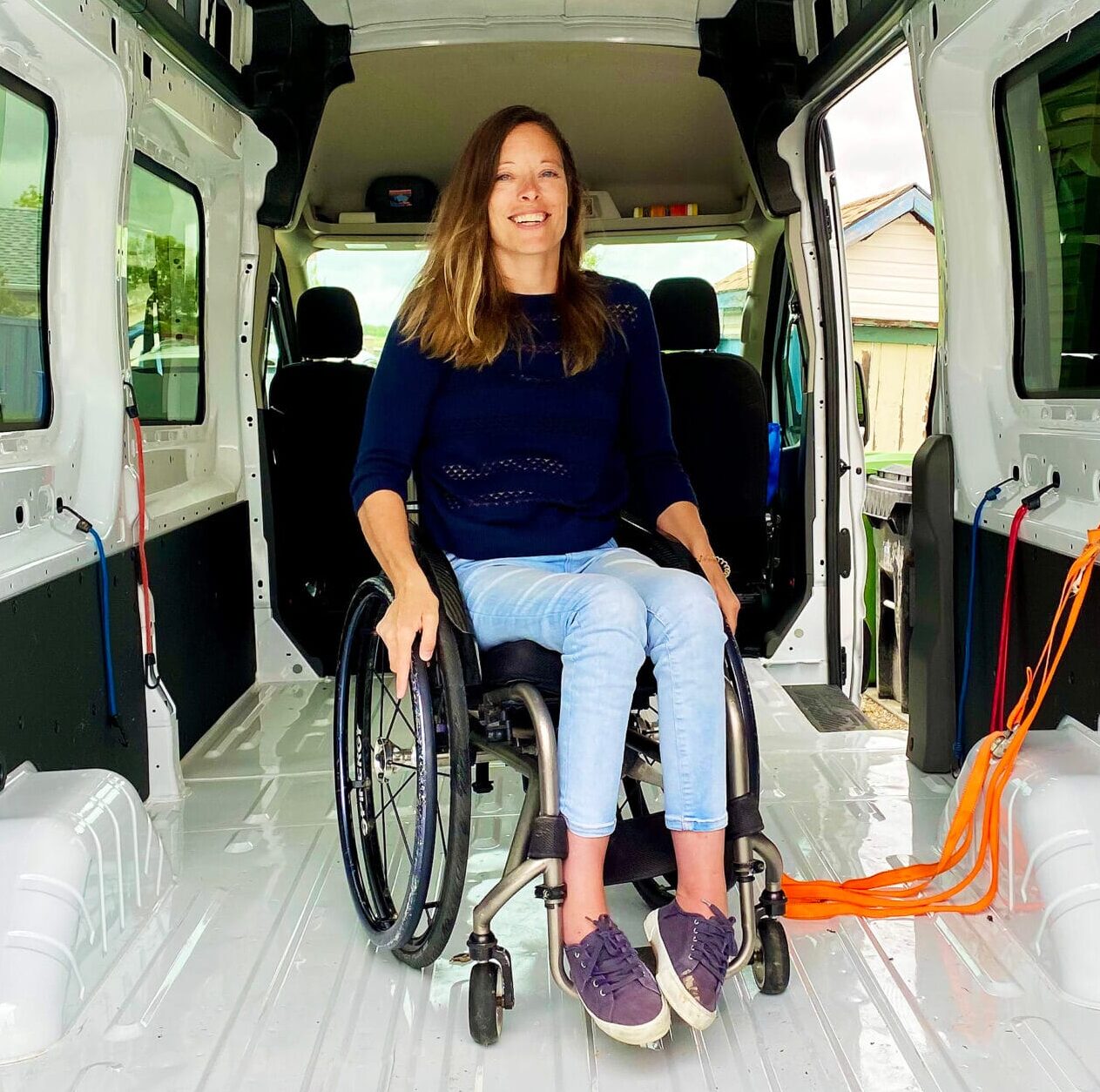
LISA FRANKS | Moose Jaw, SK
C5 incomplete
28 years post-injury
Where do you go when the colder weather hits BC?
Southern California, between LA and San Diego—there’s a little beach town that I hang out in. If the weather isn’t good there, I can be mobile—I go to the desert if it’s raining on the coast or drive two hours inland and find sun… I keep coming back to California because I’ve met so many people here. It’s a very accessible area of the U.S. and the weather is phenomenal—it’s not too hot, not too cold.
When did you start snowbirding?
This will be my fifth winter overall going south… and it’ll be three and a half winters staying down mostly full time throughout the year. The last few years I leave in October before there’s any kind of snow. It usually takes about four or five days of driving and I’ll stay in Southern California until around April.
Why did you start travelling during the winter? What was the main reason?
I’m from Saskatchewan and our winters are so brutal. So, I just wanted to get away from snow and the -20°C weather…Saskatoon has been my home for the last 20 some years and I’m able to rent out my property while I live down [in California]—that’s what provides me income to be able to do this.
How do you travel to your snowbird destination?
My first year in California was in my SUV… I had a little SUV and I had a platform bed and a cooler in it. I have a background in sports and I’m pretty social so I knew people I could stop and stay with along the way that first year. I was really relying on familiar faces to help support me, but now that’s old news. I can figure things out on the road and adapt to whatever.
I’ve also designed a van that I stay in that’s all accessible for me… I ordered a blank cargo van that came with two front seats and the rest of the back was empty. I have a surfboard and a mountain bike so I designed the van to fit those things and made sure the living area had enough room for my wheelchair to maneuver around and that I could reach everything. I also had a wheelchair lift installed. The biggest challenge was that my bike is so high. I ended up making my bed high enough, so it fits under it and then I have a bench next to my bed with a lift that raises up to the height of the bed… A lot of thought went into it.
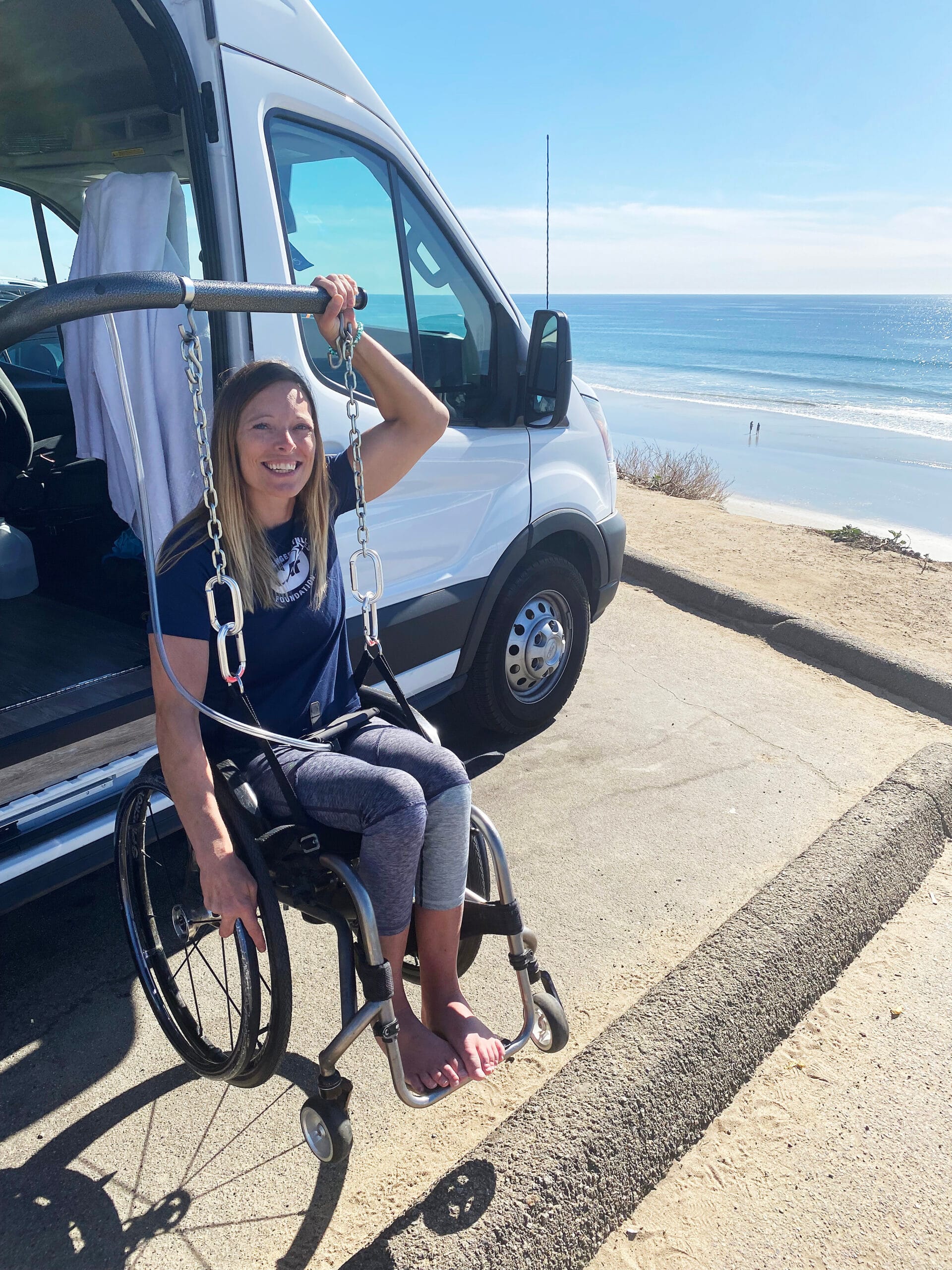
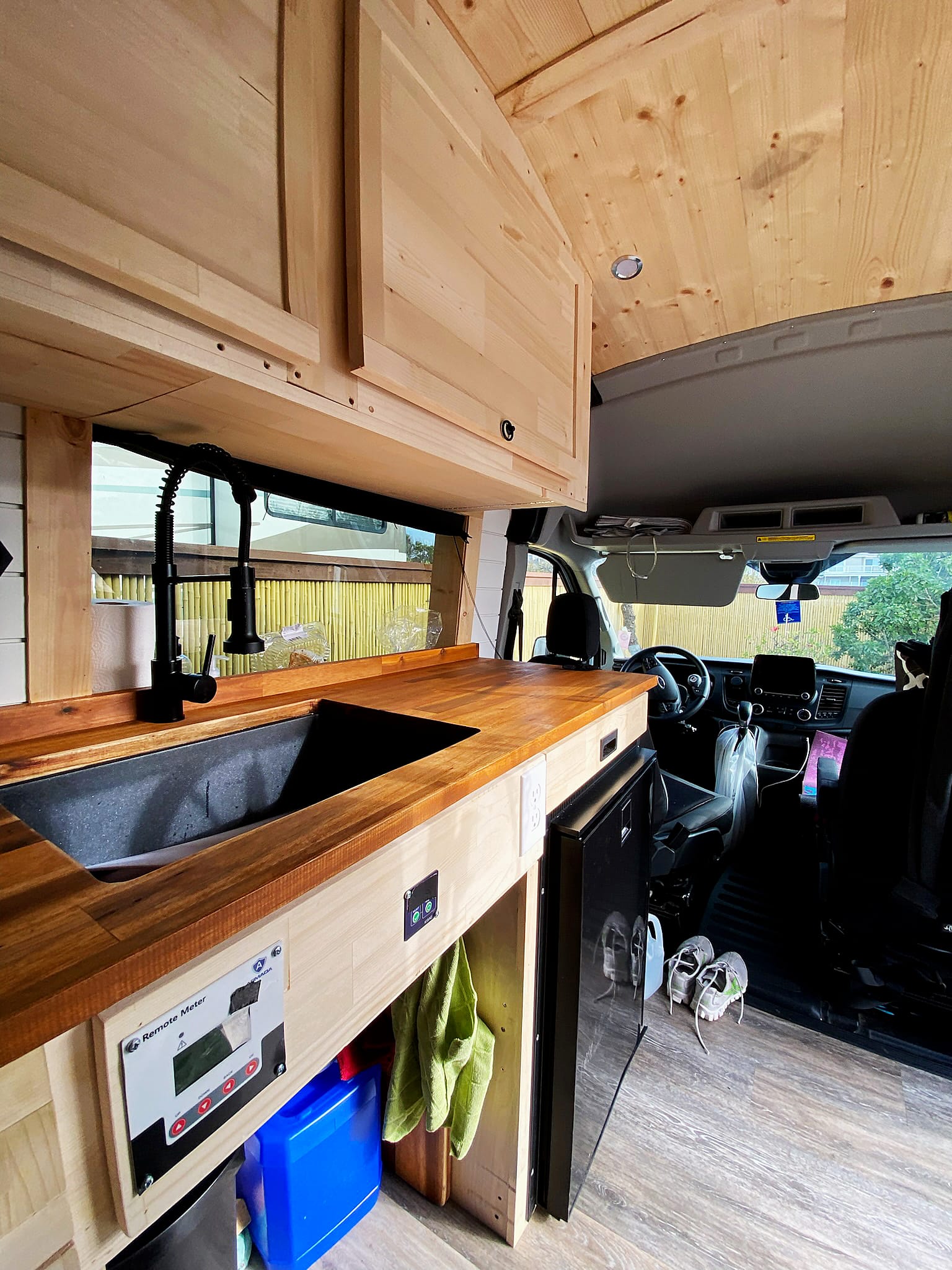
How do you prepare for health-related issues, equipment needs, or medication requirements while you’re away?
Before I leave, I forward my mail and purchase travel insurance. I get all of my prescriptions ahead of time and I get about six weeks’ worth of catheters and other medical supplies… I have a bit of an extra challenge when it comes to [supplies] because I don’t have a fixed address when I snowbird. I’m always kind of planning out my route and making sure that as my supplies are getting low, I know where I’m going to next and where I can get them sent to a general post office.
Because I’ve made the trip a few times now I also know where there are places that I can stop to find the accessible bathroom or refill my water tank in the RV at an accessible stop… there’s also tools like the Overlander app that I use. It tells you things like pullouts that are good for sleeping at night or where you can shower. It’s a crowdsourced app and other travellers have inputted information you can view or add to.
Have you encountered any unexpected challenges while snowbirding abroad? What has been your worst experience?
I’ve had minor things. I tore a ligament in my hand once and waited about 10 days or so before crossing the border back to Canada because it was my first year and I bought the cheap insurance where you had to pay a deductible. So, I waited that time, but I decided that I did not want to be in that situation ever again of having to weigh out whether I should go get looked at or not. From then on I always chose the zero deductible travel insurance. I also remember my first night where I wasn’t in an established campground or at a friend’s house and I slept in a Home Depot parking lot or something like that… I didn’t get a wink of sleep because I was so anxious all night. But now? I just put my ear plugs in and crash.
In your opinion, what’s the best part about being a snowbird?
I think the freedom to go wherever. The van is so mobile—if someone says oh, we’re going to go to the desert tomorrow I just need to put in the GPS coordinates and go. I don’t have to pack anything. I can be spontaneous and take on whatever opportunities come my way… Before this, I had a nine to five job, and I was always structured and scheduled. I didn’t have any free time, so I’m taking full advantage of it now.
At one point I also thought I was the only person out there with a high-level injury doing this nomad life but there are so many people. I have a YouTube channel (@KeepinItWheel306) and through likes and comments I know there’s a lot of wheelchair users and people out there doing this type of thing.

What is the biggest lesson you’ve learned since you started moving away for the winter?
Before I started out, the biggest concern from my family and friends was, what happens if you break down or something? But I’ve had breakdowns and I’ve been able to work through it on my own. The more you do that, the more confidence you have that you can tackle whatever’s next. I’ve also got quite a community now since I started my YouTube channel showcasing my lifestyle… it’s been really neat to see that community and get positive feedback. It’s really motivated me to keep going and is a good reminder that there’s good people out there.
Do you have any tips or tricks you can share with others who are considering snowbirding for the first time?
I would say you could start by doing some research online. I researched destinations based on weather or accessibility and access to interesting activities. Maybe start with a destination that you know you want to go to and build off of that. Doing the research to begin with is a big kind of peace of mind thing, just to have of a plan when you’re not experienced… and then being open to experiencing things from there.
Follow along with Lisa’s adventures on her YouTube channel Keepin It Wheel 306 or on Instagram @keepinitwheel306!

LISA SCHULTZ | Vernon, BC
C6/C7 incomplete
36 years post-injury
Where do you go when the colder weather hits BC?
Yuma, Arizona. I’m a C6/C7 incomplete Quadriplegic… [and] have the most incredible husband who takes care of me [and] allows me to be a snowbird.
How long have you been snowbirding?
For the past 13 winters we have been lucky enough to winter in Arizona!
Why did you start travelling during the winter? What was the main reason?
My parents were snowbirds for three years in Yuma before we started going there. After many phone calls hearing about the warm, sunny weather, it was a no-brainer compared to living on Vancouver Island in the damp, rainy, dreary, sometimes snowy winters. My husband also has rheumatoid arthritis and so the main reason was to go to a warm, dry climate for both of us.
How do you travel to your snowbird destination?
Our first two years we hauled our 30-foot travel trailer pulled by our full size wheelchair accessible van. My husband had built a lift so that I could independently get myself in and out of the trailer. We stayed in Yuma for six weeks the first year (2012) and 12 weeks the second (2013). We decided we’d like to spend the maximum time allowed for Canadians to be in the USA (182 days) so… we chose a small resort park in Yuma where annual park fees were affordable for us… [and] in 2014 we ordered a 400 square foot park van model. We had to adapt the design for wider hallways, wider door frames, and a roll-in shower. My chair raises so I’m able to cook and reach the sinks in the kitchen without having to lower the counters. We chose a small resort park in Yuma where annual park fees were affordable for us.
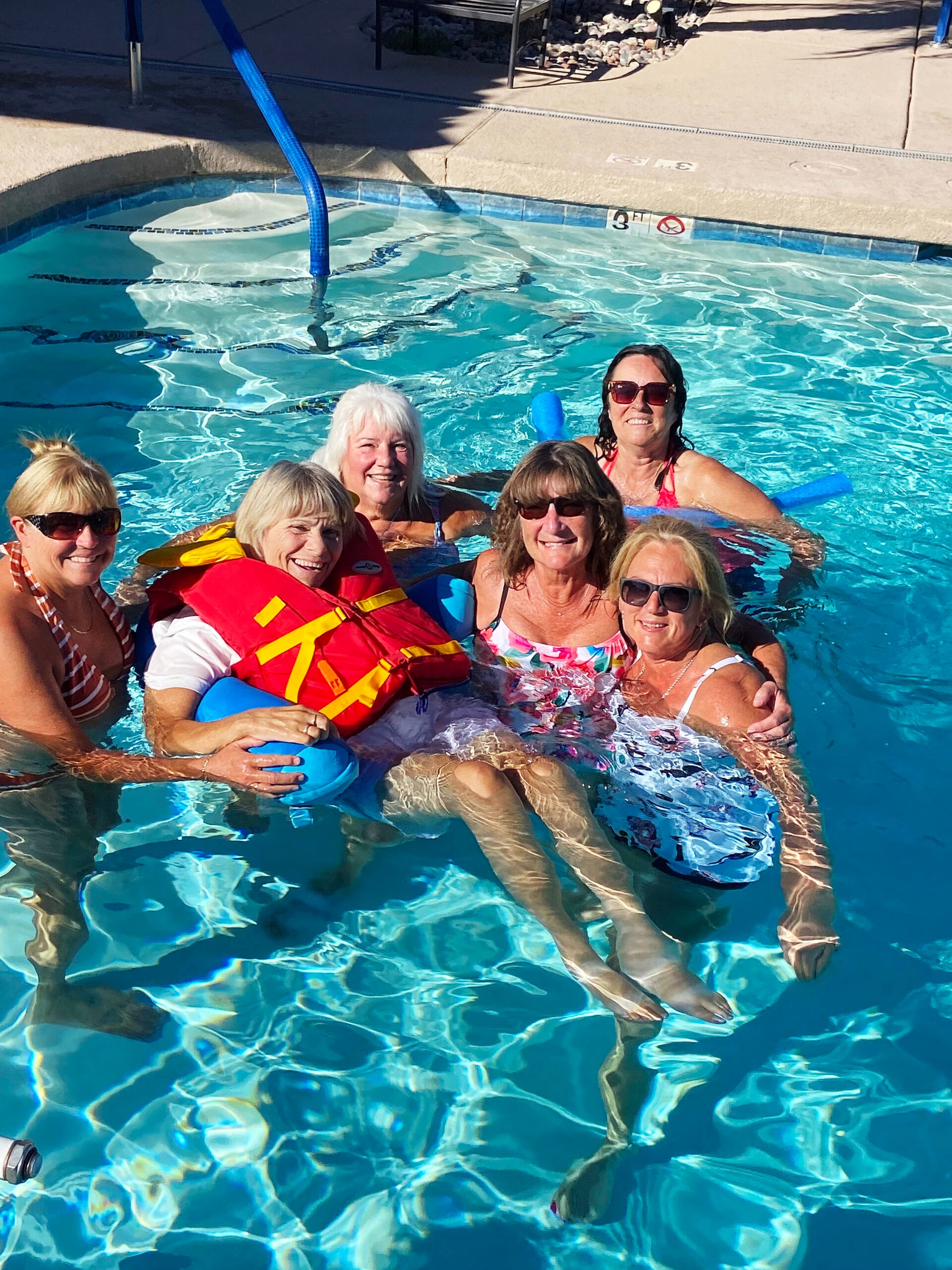
How do you prepare for health-related issues, equipment needs, or medication requirements while you’re away?
I order enough medications and medical supplies for the six months along with purchasing emergency medical insurance. I recommend that you shop around to several brokers and your bank [for insurance], as I’ve experienced significant savings for the exact same insurance company and policy.
We have a portable patient lift system which comes apart and my husband loads it in the van. We set it up over the bed and he uses it to put me in my shower chair and eventually, when I can no longer transfer into my chair, we’ll use it for that as well.
Once the lift, supplies, medication, and suitcases are in the mini-van we’re ready to go. We usually spend three nights in a wheelchair accessible motel room and arrive in Yuma on the fourth day.
Have you encountered any unexpected challenges while snowbirding abroad? What has been your worst experience?
We haven’t experienced any problems travelling abroad but we are very aware that we’re in a country that allows people to carry guns. We don’t go anywhere that is questionable and if I’m shopping after dark, I ask for an escort to the van.
In your opinion, what’s the best part about being a snowbird?
The best part about being a snowbird is finding the OG RV Resort Park in Yuma. We have made a host of lifelong friendships. People from all over Canada and the United States bend over backwards to include me and my disability. [They] have built ramps to allow me to wheel onto the shuffleboard court and included me in beanbag games (allowing me to wheel closer to the box so I can throw the bags in the holes easier). The park has a portable lift allowing me to use the pool and hot tub, a clubhouse with a daily schedule of activities, events, and games as well as dinners and dances. To me, it’s an adult playground. We love it!
Do you have any tips or tricks you can share with others who are considering snowbirding for the first time?
The only tips I can offer anyone who wants to experience being a snowbird is choose a destination and book an accessible hotel for a week or two. Look around the area [and] drive through the hundreds of parks to find the one that best fits your needs and interests. And don’t wait until your age and health becomes an issue for higher medical insurance rates.
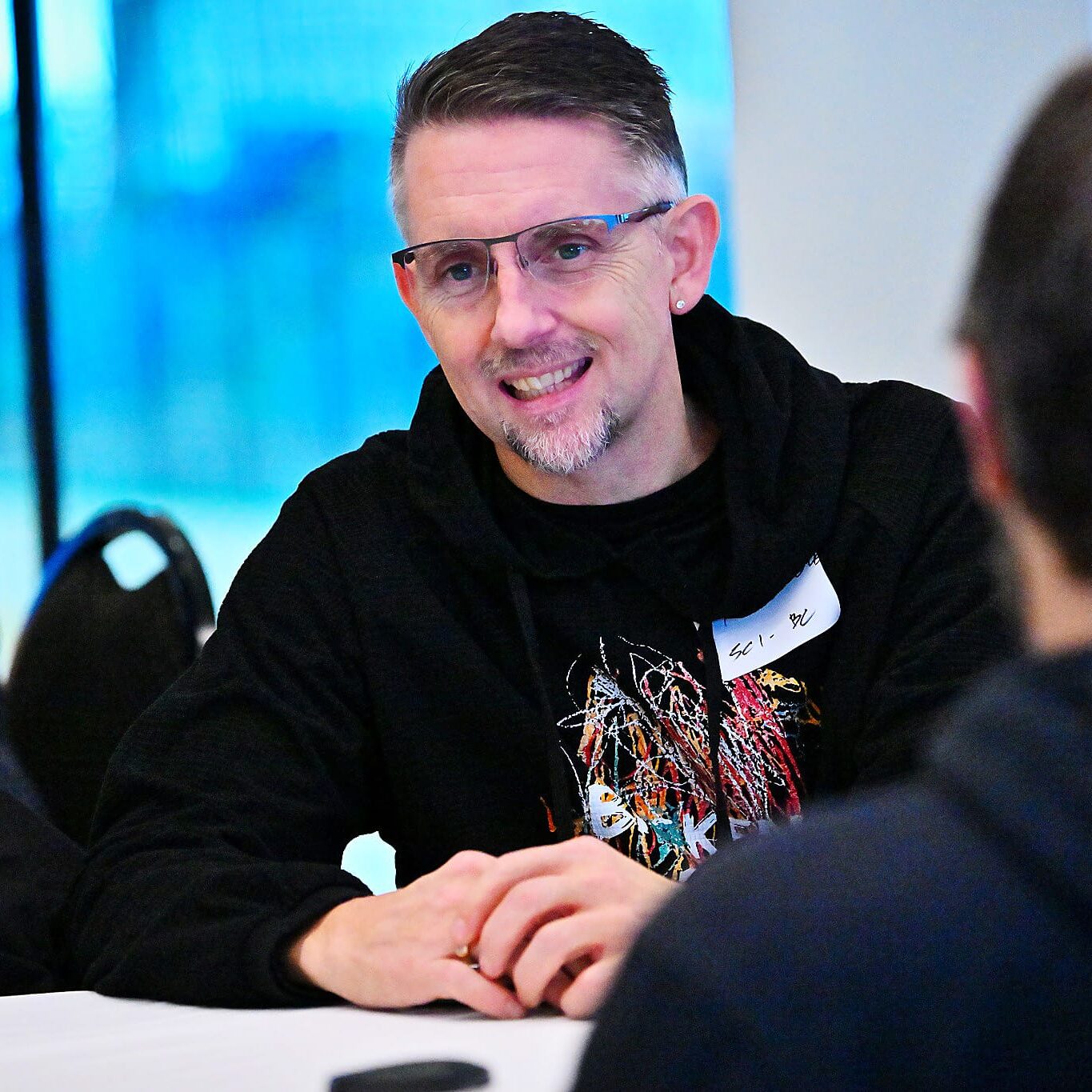
TYLER TINGLE | Kamloops, BC
T4 complete
35 years post-injury
Where do you go when the colder weather hits BC?
Mexico.
When did you start snowbirding?
I don’t know if I qualify yet as an “official” snowbird but I’ve been to Mexico [approximately] eight times. I think the first trip was in the late 90s… Last winter I was there for a month and this year we are set [to stay] for January and February. I’ve been looking at buying a space and that’s in the works now. [It] will be a bare lot [that I build on]. There will be a large palapa roof and walls on three sides but open to the drive aisle.
Why did you start travelling during the winter? What was the main reason?
Originally, it was to take a holiday away from work and have a break from winter.
How do you travel to your snowbird destination?
I fly, but in the future, I’ll drive down in [my] bus. I purchased the bus because I wanted a small motorhome with a diesel engine to tow an enclosed trailer to haul a side by side. The small motorhomes usually have a smaller gasoline engine and towing an enclosed trailer of this size is very hard on the engine and the fuel economy is horrible. The drive down will be part of the holiday where I can see different things each time I head down or home.

How do you prepare for health-related issues, equipment needs, or medication requirements while you’re away?
The bus will be self-sufficient and can be restocked along the way. As a paraplegic, a trip that is six months long will require packing more than enough supplies for that time frame…six months for me means about 1,000 catheters, 100 rubber gloves, a few tubes of lube. In case of a bladder infection I would bring a half dozen indwelling catheters, 40 leg bags (that would be enough for constant use over the six months as I’ve been dealing with reoccurring infections this past year). I would also bring at least one extra wheel for the chair and a set of tires and tubes. An extra cushion for the chair, and a power front wheel assist unit.
In your opinion, what’s the best part about being a snowbird?
There was a time when dealing with winter was offset by my winter activities of snowmobiling and wheelchair basketball. Winter for a guy on wheels in Kamloops, is wet, dirty, and cold. There’s a lot of work snow blowing my large driveway. You are stuck indoors much of the time. Thinking about the coming winter is depressing but the thought of running the side by side up an arroyo, pedaling a handcycle down the beach as the tide goes out, or snacking on a churro after pickle ball in the sun puts a smile on my face.
This article originally appeared in the Winter 2024 issue of The Spin. Read more stories from this issue, including:
- Aging with SCI video series
- Bowel research
- Entrepreneurship
And more!

